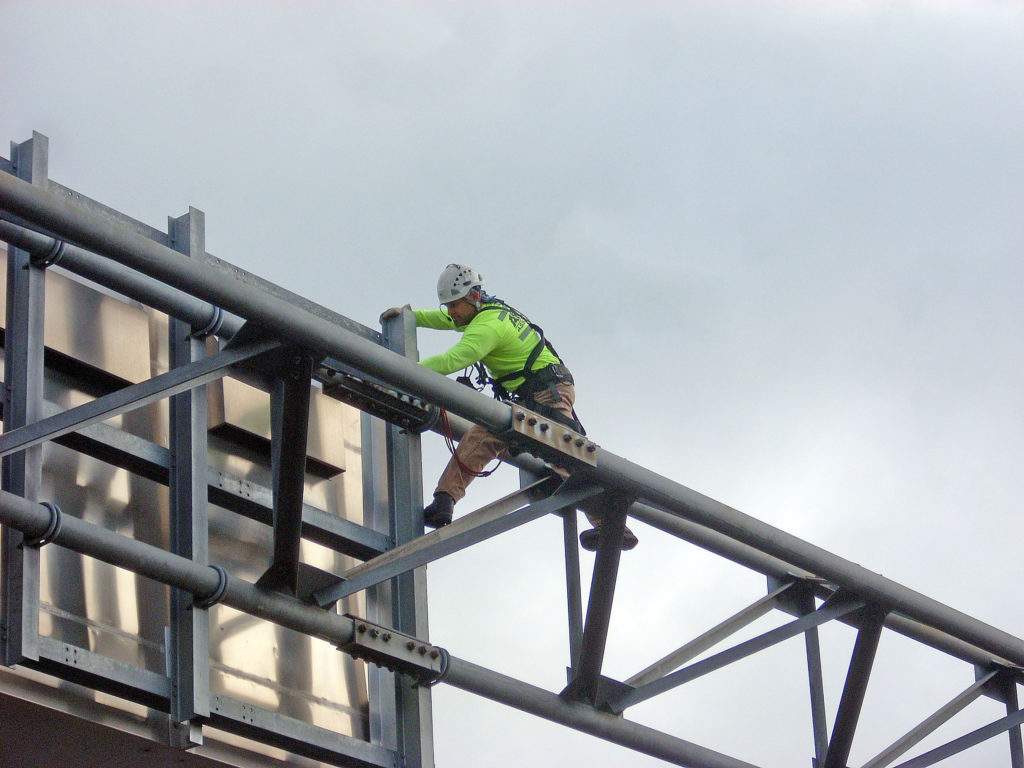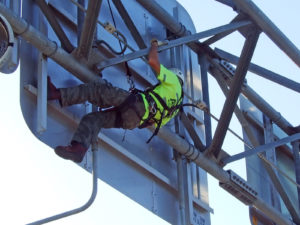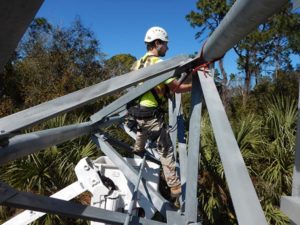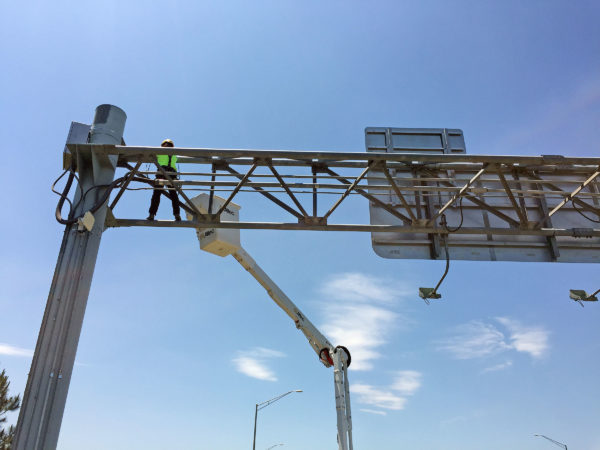Inspections Aim to Keep Signs Up Where They Belong
 “Sign, sign, everywhere a sign
“Sign, sign, everywhere a sign
Blocking out the scenery, breaking my mind,
Do this, don’t do that, can’t you read the sign?”
These lyrics from 1970 (Five Man Electrical Band) are more true today than ever. Whether we’re at the grocery store, airport, zoo, state park, or driving down the highway, signs of all shapes and sizes guide us from here to there. We look for them. We expect them. They are so abundant and predictable that most people are oblivious to their importance.
 Overhead signs on roadways – we may pass under dozens of them on a typical drive to work – are considered ancillary highway structures. Structural designers pour science, math, and engineering into the framework and support for these large and heavy structures. They need to be visible to motorists, withstand weather and wind in various climates, and stand the test of time. Most sign structures are fabricated from steel or aluminum tubes, angles, and plates erected on concrete foundations.
Overhead signs on roadways – we may pass under dozens of them on a typical drive to work – are considered ancillary highway structures. Structural designers pour science, math, and engineering into the framework and support for these large and heavy structures. They need to be visible to motorists, withstand weather and wind in various climates, and stand the test of time. Most sign structures are fabricated from steel or aluminum tubes, angles, and plates erected on concrete foundations.
They also need to be inspected regularly to ensure their durability. The Federal Highway Administration (FHWA) does not regulate sign inspections like it does highway bridges; the agency leaves this up to each state. State transportation officials need proof that signs are structurally sound, so hands-on inspections are required in many cases to detect deficiencies. Many states – Wisconsin, Florida, and Iowa among them – have intensive, hands-on inspection programs.
 Because hundreds of thousands of signs populate major roadways, transportation agencies prefer this work to be completed efficiently and with the least possible disruption to traffic. One effective way inspectors complete the work is by using rope access climbing techniques, allowing the inspector(s) to work above live traffic with minimal traffic slowdowns. Inspectors also use lift trucks from the roadway shoulders to complete the work, which requires some traffic control.
Because hundreds of thousands of signs populate major roadways, transportation agencies prefer this work to be completed efficiently and with the least possible disruption to traffic. One effective way inspectors complete the work is by using rope access climbing techniques, allowing the inspector(s) to work above live traffic with minimal traffic slowdowns. Inspectors also use lift trucks from the roadway shoulders to complete the work, which requires some traffic control.
Inspectors examine all visible surfaces, including clearing away soil and debris to effectively examine components. Deficiencies are documented with enough detail and with probable causes to record rates of change and to recommend any repairs. Inspectors also evaluate and document previous deficiencies and completed repairs. Inspectors examine tightness of bolted connections, corrosion of steel members, cracking in concrete or steel members, and overall foundation and sign support strength. The data is published in a final report to the owner agency.
 Inspectors must undergo significant training to keep themselves and the traveling public safe and to accurately determine the importance of deficiencies found. All tasks are performed according to applicable Occupational Safety and Health Administration, American National Standards Institute, and state Department of Transportation guidelines. All inspection team leaders have successfully completed the FHWA National Highway Institute training course No. 130087, Inspection and Maintenance of Ancillary Highway Structures. Inspectors also are skilled in safe lift truck use, climbing techniques, nondestructive testing methods, ladder use, proper tool handling procedures over or near traffic, and traffic control methods.
Inspectors must undergo significant training to keep themselves and the traveling public safe and to accurately determine the importance of deficiencies found. All tasks are performed according to applicable Occupational Safety and Health Administration, American National Standards Institute, and state Department of Transportation guidelines. All inspection team leaders have successfully completed the FHWA National Highway Institute training course No. 130087, Inspection and Maintenance of Ancillary Highway Structures. Inspectors also are skilled in safe lift truck use, climbing techniques, nondestructive testing methods, ladder use, proper tool handling procedures over or near traffic, and traffic control methods.
Ayres Associates has provided more than 9,000 ancillary inspections in the past 16 years for a variety of local and state agencies across the country, and our structural engineers also design new structures and design repairs or upgrades for existing signs.
The next time you pass under an “Exit Only” sign on the highway, you can be confident that a structural inspector is keeping watch to make sure this and other large structures continue to stand tall.
For more information, check our structural inspection services page; read about our inspections for Florida Department of Transportation District 5; or review our hurricane damage assessment work.

Post a comment: